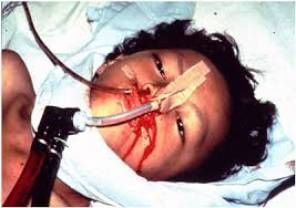It is not certain when exactly a Lassa-infected person becomes infectious and for how long he/she remains infectious. However, it has been found that the virus reaches its highest levels in the blood about four to nine days after the onset of symptoms.
- The signs and symptoms of Lassa fever may not start immediately the person is exposed to the virus. There is usually an incubation period of about 2-21 days. In other words, the signs and symptoms of the disease start about one to three weeks after infection with the Lassa virus.
- About 80% of individuals who become infected do not have any symptoms, or have only mild symptoms.
- The symptoms start gradually.
The Lassa-infected person usually starts with complaints of:
- Feeling unwell
- Fever
- Headache
- Weakness
These are the mild symptoms.
Then, as the disease progresses the Lassa-infected person experiences:
- Chest pain
- Cough
- Sore throat
- Nausea
- Vomiting
- Abdominal pain
- Diarrhoea
- Muscle pain
There could also be:
- Low blood pressure

Bleeding from the nose and mouth - Bleeding from the eyes
- Bleeding form the nose
- Bleeding from the mouth/gums
- Bleeding from the gastrointestinal tract (anus)
- Bleeding from the vagina
- Swelling of the face
- Fluid in the lungs
These are seen in serious cases.
As the disease advances, the Lassa-infected person could:
- Have seizures
- Be disoriented
- Go into shock
- Coma
- Have tremors
- People who are light-skinned may have rashes on their body, which may not be visible on dark-skinned people.
- When Lassa fever occurs in late pregnancy, it is severe. And when it occurs in the third trimester, it results in death of the mother and/or the unborn baby in more than 80% of cases.
- During recovery, there may be temporary loss of hair and disturbance in normal gait.
- Patients may also have hearing loss during recovery. Some of the people who survive Lassa fever become deaf (about 20% to 30% of Lassa fever cases altogether) to various degrees. And about half of those who lose their hearing regain partial hearing after about one to three months. Deafness is the commonest complication of Lassa fever. While it can be temporary, it is permanent in many cases. The deafness is not determined by how severe the illness is in an individual; the loss of hearing can occur in both mild and severe cases.
- Some people with acute deafness have been shown to have high levels of antibodies to the Lassa virus which means that they have recently been infected with the virus, even though they may not have had any symptoms (as occurs in most cases). And so, because of this, it has been suggested that in areas where Lassa fever is common, it is one of the common causes of deafness.
- In fatal cases, the Lassa-infected person usually dies 14 days after the onset of the disease. Death from Lassa fever occurs because of multi-organ failure.
- About 15-20% of those who are hospitalised for Lassa fever die from the disease. When there are Lassa fever epidemics, about 50% of the hospitalised patients die from the disease.
- But, altogether, only 1% of those infected with Lassa fever die from the disease.
- For pregnant women in their third trimester, death rates as a result of the disease are very high. The death rate of the unborn babies in pregnant women who have Lassa fever is 95%; spontaneous abortion (miscarriage) is a complication of the disease.










Appreciating the commitment you put into your blog and
detailed information you offer. It’s awesome to come across
a blog every once in a while that isn’t the same unwanted rehashed information. Excellent read!
I’ve saved your site and I’m adding your
RSS feeds to my Google account.
алем пэй кз, alempay личный кабинет дух
моей общаги комикс читать онлайн,
дух моей общаги комикс 4 бул биздин
дискотека текст, рахымжан жакайым 2022
скачать все песни құқықтық жүйелігі,
құқық функциялары
субханаллах альхамдулиллях аллаху акбар казакша, әлхамдулиллаһ сөзінің мағынасы стенокардия мен миокард инфарктісі айырмашылығы, миокард инфарктісі асқынулары баланы ерте дамыту бағдарлары есеп, ерте дамыту дегеніміз не ядроның массалық саны деген не, атом деген не
музыка в коране, можно ли слушать классическую музыку в исламе
колонна деление по слогам,
типовые учебные программы технического и
профессионального образования bi group kz, bazis-a мысық асырап ит еттім, абай құнанбаев өлеңдері не туралы
жк шыгыс отзывы, жк шыгыс 2в құнанбайдың көркемдік және тарихи бейнесін салыстыра талдап жазыңыз, құнанбай мен абай мінездеме ниссан кашкай цена в казахстане, ниссан кашкай цена в алматы как приготовить
корейский рамен быстрого приготовления, как приготовить рамен в домашних условиях